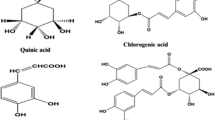Abstract
The present study evaluates the gastroprotective properties of acetone extract, chloroform, and methanol fractions, α-spinasterol (1); 1,3-dihydroxy-7-methoxyxanthone (2); and 1,7-dihydroxy-2,3-methylenedioxyxanthone (3) obtained from Polygala cyparissias (Polygalaceae). Gastroprotective assays were performed in mice using ethanol/HCl and nonsteroidal anti-inflammatory drug (NSAID)/bethanechol-induced ulcer models. Chloroformic fraction showed no interesting results. On the other hand, in the ethanol/HCl-induced ulcer model, the treatment using doses of 50, 125, and 250 mg/kg promoted ulcer inhibition of 45.19 ± 12.93%, 62.99 ± 3.49%, and 67.40 ± 4.75% for acetone extract and 43.70 ± 5.12%, 64.56 ± 5.64%, and 74.49 ± 6.13% for methanol fraction. In the model of NSAID/bethanechol-induced ulcer, the ulcer inhibitions in the same doses were 28.12 ± 12.45%, 60.16 ± 6.58%, and 77.86 ± 7.18% for the acetone extract and 46.09 ± 6.92%, 67.45 ± 4.36%, and 75.00 ± 2.92% for the methanol fraction. In view of the antiulcer potential of the acetone extract and its high yield and xanthone content, it was submitted to chromatographic procedures, giving compounds 1–3, which were also evaluated in the ethanol-induced ulcer model. The results showed that at a dose of 50 mg/kg, these compounds reduced the percentage of ulcer by around 71.26 ± 9.40%, 81.10 ± 5.75%, and 86.22 ± 3.42%, for compounds 1, 2, and 3, respectively. The antiulcerogenic activity of P. cyparissias may be attributed, at least in part, to these compounds.

Similar content being viewed by others
References
Balunas MJ, Kinghorn AD (2005) Drug discovery from medicinal plants. Life Sci 78:431–441
Banerji A, Deshpande AD, Prabhu BR, Pradhan P (1994) Tomentonone, a new xanthonoid from the stem bark of Calophyllum tomentosum. J Nat Prod 57:396–399
Bo T, Liu H (2004) Separation methods for pharmacologically active xanthones. J Chromatogr B 812:165–174
Chan FKL, Leung WK (2002) Peptic-ulcer disease. Lancet 360:933–941
De Andrade SF, Comunello E, Noldin VF, Monache FD, Cechinel-Filho V, Niero R (2008) Antiulcerogenic activity of fractions and 3, 15-dioxo-21α-hydroxy friedelane isolated from Maytenus robusta (Celastraceae). Arch Pharm Res 31:41–46
De Campos ROP, Santos ARS, Vaz ZR, Pinheiro TR, Pizzolatti MG, Cechinel-Filho V, Monache FD, Yunes RA, Calixto JB (1997) Antinociceptive properties of the hydroalcoholic extract and preliminary study of a xanthone isolated from Polygala cyparissias (Polygalaceae). Life Sci 61:1619–1630
El Sayah M, Cechinel-Filho V, Pinheiro TR, Yunes RA, Calixto JB (1999) In vitro effect og the extract and the 1, 7 dihydroxy-2, 3-dimethoxy xanthone from Polygala cyparissias on the contractions induced by inflammatory mediators and ovalbumin in normal and actively sensitized trachea from guinea pig. Inflamm Res 48:218–223
Falcão HS, Mariath IR, Diniz MFFM, Batista LM, Barbosa-Filho JM (2008) Plants of the American continent with antiulcer activity. Phytomedicine 15:132–146
Gurib-Fakim A (2006) Medicinal plants: traditions of yesterday and drugs of tomorrow. Mol Aspects Med 27:1–93
Halberstein RA (2005) Medicinal plants: historical and cross-cultural usage patterns. Ann Epidemiol 25:686–699
Kinoshita M, Tsunehisa N, Tamaki H (1995) Effect of a combination of ecabet sodium and cimetidine on experimentally induced gastric-lesions and gastric-mucosal resistance to ulcerogenic agents in rats. Biol Pharm Bull 18:223–226
Klopell FC, Lemos M, Sousa JPB, Comunello E, Maistro EL, Bastos JK, De Andrade SF (2007) Nerolidol, an antiulcer constituent from the essential oil of Baccharis dracunculifolia DC (Asteraceae). Z Naturforsch 62c:537–542
Liu Y, Wang M (2008) Botanical drugs: challenges and opportunities contribution to Linnaeus Memorial Symposium 2007. Life Sci 82:445–449
Lu H, Graham DY (2006) New development in the mechanistic understanding of peptic ulcer diseases. Drug Discov Today 3:431–437
Marotta F, Tajiri H, Safran P, Fesce E, Ideo G (1999) Ethanol related gastric mucosal damage: evidence of a free radical-mediated mechanism and beneficial effect of oral supplementation with bionormalizer, a novel natural antioxidant. Digestion 60:538–543
McChesney JD, Venkataraman SK, Henri JT (2007) Plant natural products: back to the future or into extinction? Phytochemistry 68:2015–2022
Pinheiro TR, Cechinel-Filho V, Santos ARS, Calixto JB, Monache FD, Pizzolatti MG, Yunes RA (1998) Three xanthones from Polygala cyparissias. Phytochemistry 48:725–728
Rainsford KD (1987) Gastric ulcerogenicity of non-steroidal anti-inflammatory drugs in mice with mucosa sensitized by cholinomimetic treatment. J Pharmac Pharmacol 39:669–672
Schmeda-Hirschmann G, Astudillo L, Rodríguez JA, Theoduloz C, Yáñez T (2005) Gastroprotective effect of the Mapuche crude drug Araucaria araucana resin and its main constituents. J Ethnopharmacol 101:271–276
Sun SB, Matsumoto T, Yamada H (1991) Effects of a polysaccharide fraction from the roots of Bupleurum folcatum L. on experimental gastric ulcer models in rats and mice. J Pharm Pharmacol 43:699–704
Szabo S, Vattay P (1990) Experimental gastric and duodenal ulcers. Gastroenterol Clin North Am 19:67–85
Weinhold TS, Bresciani LFV, Tridapalli CW, Yunes RA, Hense H, Ferreira SRS (2008) Polygala cyparissias oleoresin: comparing CO2 and classical organic solvent extractions. Chem Eng Process 47:109–117
Zanatta F, Gandolfi RB, Lemos M, Ticona JC, Gimenez A, Clasen BK, Cechinel-Filho V, De Andrade SF (2009) Gastroprotective activity of alkaloid extract and 2-phenylquinoline obtained from the bark of Galipea longiflora Krause (Rutaceae). Chem Biol Interact 180:312–317
Acknowledgements
We are grateful to the Conselho Nacional de Desenvolvimento Científico e Tecnológico (CNPq), Coordenação de Aperfeiçoamento de Pessoal de Nível Superior (CAPES), Fundação de Apoio à Pesquisa Científica e Tecnológica do Estado de Santa Catarina (FAPESC), and Universidade do Vale do Itajaí (UNIVALI) for their financial support.
Author information
Authors and Affiliations
Corresponding author
Rights and permissions
About this article
Cite this article
Klein, L.C., Gandolfi, R.B., Santin, J.R. et al. Antiulcerogenic activity of extract, fractions, and some compounds obtained from Polygala cyparissias St. Hillaire & Moquin (Polygalaceae). Naunyn-Schmied Arch Pharmacol 381, 121–126 (2010). https://doi.org/10.1007/s00210-009-0485-x
Received:
Accepted:
Published:
Issue Date:
DOI: https://doi.org/10.1007/s00210-009-0485-x




